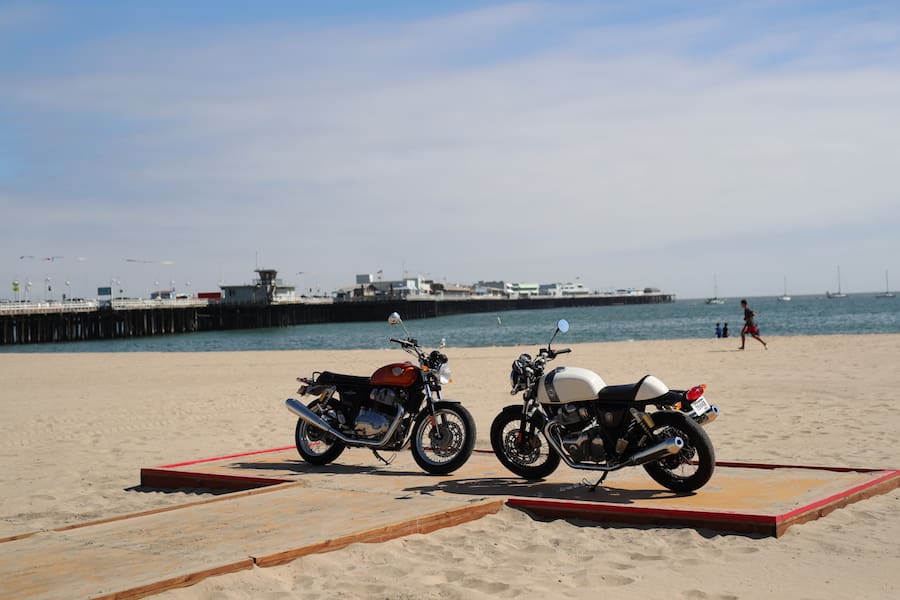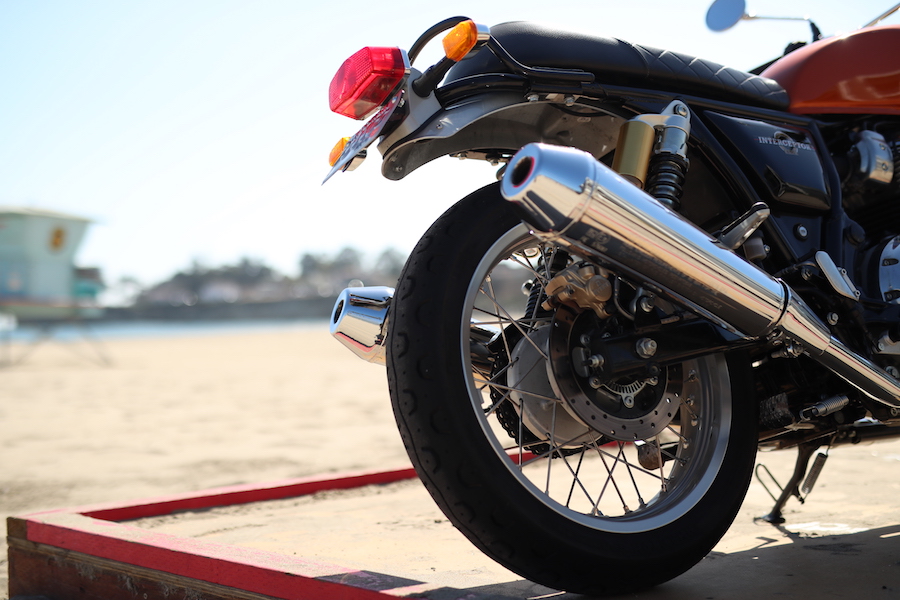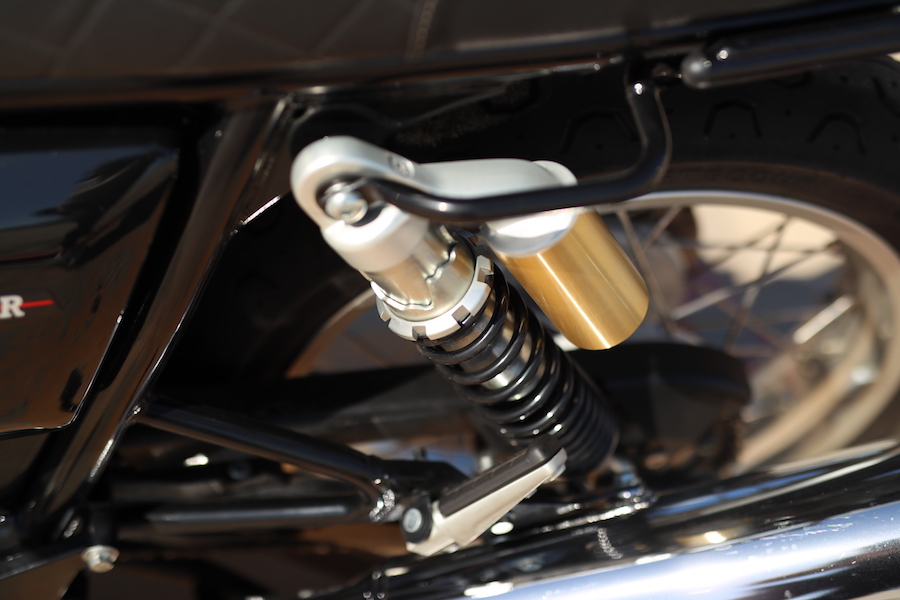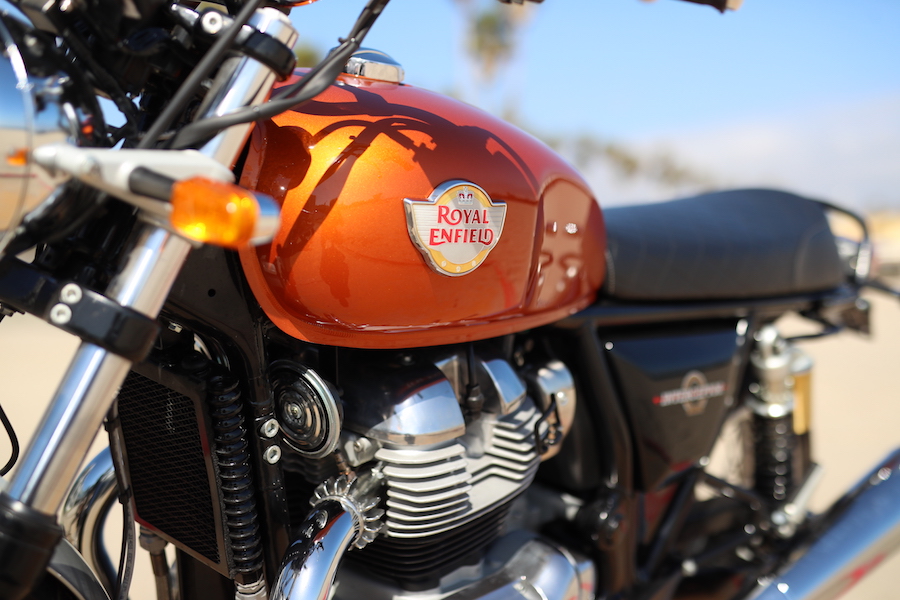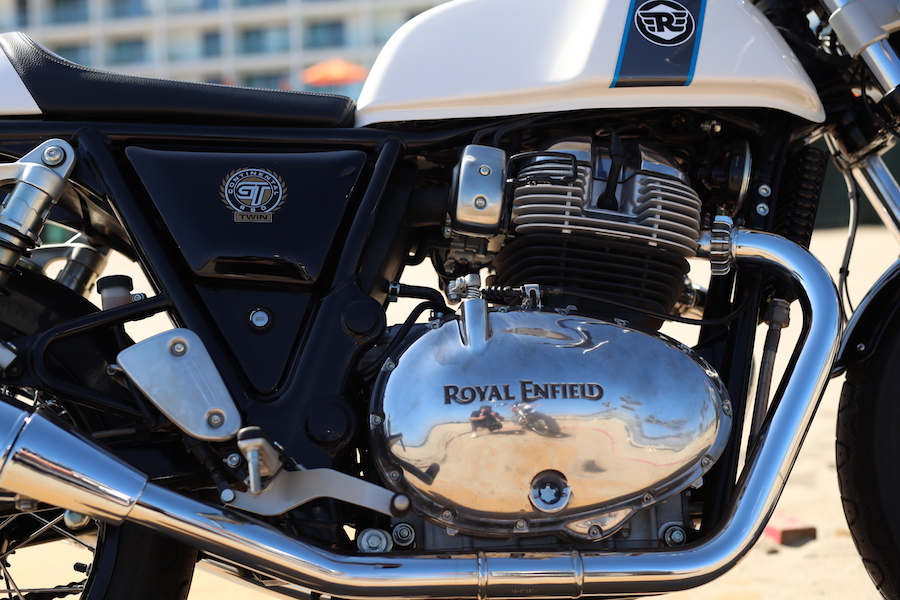Since taking control of the company, Royal Enfield’s CEO Siddartha Lal has rebuilt the once very British brand from a 30,000 units per annum basket case to an 820,000 units per annum powerhouse. Sid, as he’s known to everyone, is not your average CEO. His laid-back and approachable manner fits the California backdrop where he he’s chosen to his company’s two new 650cc motorcycles. So well, in fact, that one scribe – not realising the young bloke excitedly waiting to have his helmet custom painted at the launch party was the multi-millionaire footing the bill – asked him if he worked at Royal Enfield. In his typical, unassuming fashion, Sid simply replied: “I’m lucky, I had a family connection to get a job.”
Understanding what Sid is about adds context. Here’s a man whose love of motorcycling drives his passion for business. I enjoyed a very spirited ride with Sid as we tested his latest 650cc parallel-twin offerings, the guy certainly can ride and loves to do so at any opportunity.
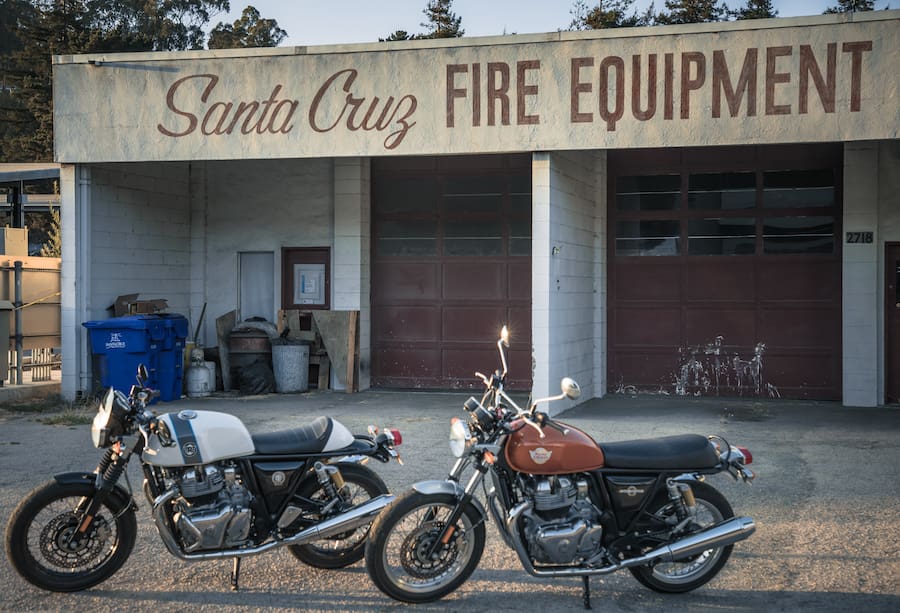
Understanding why we’re in the surfing town of Santa Cruz adds context, too. Because it was California’s post-war motorcycling boom that created a revolution in British motorcycle manufacturing, helping Royal Enfield establish itself as a global brand. And Sid is hoping it will be a case of history repeating itself.
Both models are powered by the company’s all-new air/oil-cooled 648cc parallel-twin cylinder engine, and are based on legends from Royal Enfield’s back catalogue; the Continental GT and Interceptor. While the names have been resurrected, and the styling somewhat familiar, the design and engineering effort put into the two bikes at the company’s new state-of-the-art technology centre at Bruntingthorpe in the UK is all 21st Century.
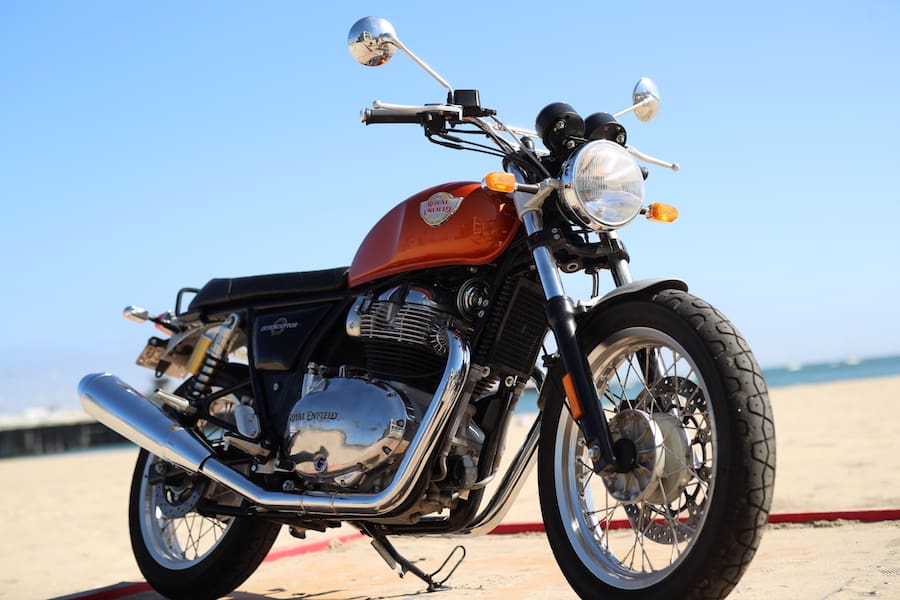
Interceptor 650
In addition to the engine, both models share the same steel, double-cradle chassis design, conventional 41mm fork and gas-charged piggyback reservoir twin shocks (with five-stage preload), and a Bybre braking package. Separating the two is merely a name, cosmetic changes and the seating position, but they possess markedly different personalities.
The GT is the café racer; it has a single seat, 12.5L fuel tank with cutouts, a Monza-type filler cap, low-ish swan-neck clip-on handlebars, rearset footpegs and black rims for its alloy spoked wheels. The Interceptor, on the other hand, is a classic roadster with a braced scrambler-style handlebar, slimmer but larger-capacity 13.7L fuel tank, larger flat seat with room for a pillion, footpegs set 65mm further forward, a centrestand and polished alloy rims.
Inspecting the new bikes ahead of two full days of riding through the spectacular mountain roads around Santa Cruz, revealed how the build quality has taken another step forward since I first inspected the pre-production bikes at last year’s EICMA show in Milan. Attention to detail is apparent, including the way the oil cooler and lines match up perfectly with the down tubes of the frame, making them much less noticeable. There is barely a screw, hose or cable out of place, and a nice touch is a rear brake lever that looks like a gear shift lever to emulate the right-hand gearshift on the original Interceptor. The simple two-clock analogue dash features a rev counter and a speedo with a built-in LCD screen displaying odometer and trip metres, but no clock or gear indicator.

Continental GT 650
The large selection of eye-catching retro paintwork choices are available across the Standard, Custom and Chrome colour selections; the latter two carrying a slightly higher price tag. While the switchblocks can’t avoid looking a bit bland due to the absence of electronics other than EFI and ABS, they are thankfully not made of shiny, cheap-looking black and red plastics. I wasn’t a fan of the large plastic lens and bulb-type tail light and indicators on the 2012 Continental GT, and even the lovely lines of the new GT and Interceptor can’t make up for using a similar set up this time – slim LED units would look great on both bikes.
- Interceptor 650
The centrepiece of the styling is the all-new parallel-twin. It’s a physically large engine which fills the frame and has a genuine old-school look about it. The highly-polished engine covers match the chrome exhaust, which is twin-skinned to add thickness and prevent discolouring.
The world launch was split across two days of riding, providing enough time to evaluate each machine thoroughly. First up was the Continental GT and, as I climbed aboard, the lengthy reach to the clip-on bars surprised me. Despite the grips being set above the top triple-clamp, a hunkered-down position is taken once riding. Apparently the headstock was moved back 25mm following testing of early prototypes; I can only imagine how much of a stretch that must have been for the much-shorter-than-I Royal Enfield test riders. The single seat is quite firm, and after seeing a model fitted with the accessory twin seat with a rear cowl, I wished the designers had gone with that as the standard seat to hide the exposed rear subframe on the single-seat model.
The 793mm seat height and slim design allow easy reach to the ground, and even my lanky 192cm frame found the seating position extremely comfortable, with my knees fitting snuggly into the cutouts of the petrol tank.
The twin-cylinder engine is again the star of the show when it comes to riding, but it’s only a whisker ahead of the chassis. The original Continental GT was a single cylinder, but the Interceptor was a parallel-twin like this new bike. However, the original Interceptor used a 360-degree crank firing sequence, whereas the new engine uses a 270-degree crank and a balancer shaft. The sound from the stock exhaust is an enjoyable angry burble, similar to a V-twin, and the aftermarket (but still Euro-4 compliant) S&S slip-ons that one of the bikes in our group was carrying, sound even better.

Continental GT 650
Within 10 minutes, we were into some of the best mid-capacity riding roads I’ve had the pleasure of attacking. The seemingly endless network of positive-cambered left and right-hand bends connected by short straights would be wasted on a large-capacity sportstbike, this is middleweight country, allowing Royal Enfield’s new chassis and engine combination to shine.
And the engine shines bright. The word I received is the final flash for the ECU was received by former Keihin computer engineer Takeshi-san and his team just weeks prior to the launch. Not because it was running late, but because they wanted it to be the best it could be, and the effort was worth it. From throttle opening through to the 7500rpm rev limiter, the delivery of power is smooth. There isn’t a hint of snatchiness at throttle opening, a plus for new riders. The engine does only produce 35kW and 52Nm, so don’t expect the performance of a 750cc machine, but it is nicely spread, providing a predictable surge of torque as soon as the throttle is twisted at corner exit. The slip-assist clutch has a light feel, which is a good thing as the newness of the engines meant it needed to be used most of the time due to the six-speed box feeling tight and slightly notchy. Other than having the back end step out when I accidentally dropped down to first gear and released the clutch on corner entry (there’s no gear indicator), the slip part of the slip-assist clutch also does its thing well.
On the open road, I found myself sitting between 100-110km/h in fourth gear, enjoying the sound and performance from the 270-degree crank parallel twin, as it smoothly hummed along at 5000rpm with the single gear-driven counterbalancer removing vibrations. Clicking up two gears to the overdrive sixth for freeway riding will reveal an engine happy to sit on 120km/h all day, and while a click back to fifth is required to gather momentum quickly, the ton is no problem. I found 100mph (160km/h) at 6500rpm could be sustained for longer than my open-face helmeted eyes and ears could bear. Royal Enfield now has a Continental GT that’s a genuine ton-up machine.
The seating position of the GT places the rider’s bodyweight on the handlebar providing plenty of feel for what the front-end is doing. The small seat, with its limited padding, does similar at the rear. The new 650 twins may be built to a price point, but the engineering team has achieved a lot with its brief. At a relaxed pace, the Indian-made Gabriel 41mm non-adjustable conventional fork with 110mm of travel is compliant and well damped, absorbing bumps in the road easily, while the rear – which feels a little heavily sprung compared to the front – does tend to skip over rough surfaces a little.
Once the pace quickened, the twin rear-shock design did begin to reveal why progressive rate linkages and monoshocks replaced the idea decades ago. The tight springs make the rebound a little too quick causing the bike to bounce, but to its credit, there was no bottoming out despite the short 88mm stroke length. These minor and expected suspension gripes are more than made up for by the lovely frame that’s stiff and predictable. At speeds that were possibly a little above the speed limit, the quick change of directions required through the long sections of flowing S-bends were handled easily, highlighting the engineering work that has gone into tuning the chassis to make sure it handles well on its retro-looking 18-inch wheels.
The relatively sharp steering geometry of 24º head angle and 106mm of trail, coupled with a 1400mm wheelbase, combine to make it a confident little steering that retains a connected feel to the road at all times.
The 18-inch spoked wheels are shod with Pirelli Phantom Sportcom tyres developed for the two new models. They go a long way to providing the easy and fun-riding nature of the bike that will make it both enjoyable and confidence-inspiring for the target market of new riders and those looking for a relaxed mid-capacity ride, the secret ingredient for any successful LAMS machine.
- Continental GT 650
Royal Enfield has chosen to design the two new models to suit all of its markets, meaning the engineers faced the challenge of producing a bike that would be just as home on the smooth roads of California’s state parks, as it will be on the torturous hot, dusty and potholed roads of India. My experience with the bike is only on the former and from that angle, the design brief has been met.
ByBre, Brembo’s Indian arm, supplies the brakes. Up front, the stopping power of the single twin-pot caliper and 320mm disc is good with nice feedback through the lever, but could benefit from a little more initial bite to help pull up the GT and Interceptors claimed kerb weights of 198kg and 202kg respectively. At the rear, the single-pot caliper and 240mm disc is great for settling the bike mid corner, but felt a little vague when called into action for heavy braking; the rear ABS was also a little hit-and-miss allowing the rear tyre to momentary lock when the brake pedal was mashed hard.
Following a night of Bollywood-style partying, day two’s hangover cure was cruising the coastline on the Interceptor. You would think by just adding a different seat, tank, handlebar and slightly further forward footpegs, it would still feel pretty much the same, but the Continental GT and Interceptor have very different personalities. But the longer, higher (804mm) and additionally padded seat on the Interceptor provides better comfort than the GT, and the high-set handlebar changes the rider triangle. Both models have a similar peg-to-seat length, but the additional room to move on the Interceptor makes it feel longer than the GT. The rider is also not stretched out as much, thanks to the swept back and upright scrambler style ’bar, allowing more options for body position. The Interceptor is four kilograms heavier at a claimed 202kg (kerb/no fuel). Cruising through the main street of Santa Cruz on the Interceptor – sitting high and upright – just felt, sounded and looked right.
- Continental GT 650
Another enjoyable blast through the Redwood forest revealed the changes also affect the front end of the bike, which felt a little less willing to turn in than the GT. The wider and higher handlebar diluted the nice front-end feel I’d enjoyed had on the GT, possibly due to the reduced bodyweight weight over the fork not creating the same level of compression at corner entry. And while the padded seat of the Interceptor reduced the feeling of bounce at the rear-end, I preferred the single seat on the GT.
Other riders I spoke with said they preferred the Interceptor over the GT, but what we did agree on was both are enjoyable, mid-capacity, retro-styled machines blessed with a great little engine and chassis, especially when the expected price point is taken into consideration.
If we are correct, Royal Enfield should have a winner on its hands, edging Sid Lal and his team a step closer to the world domination they desire – right after another ride. It’s all about getting your priorities right.
